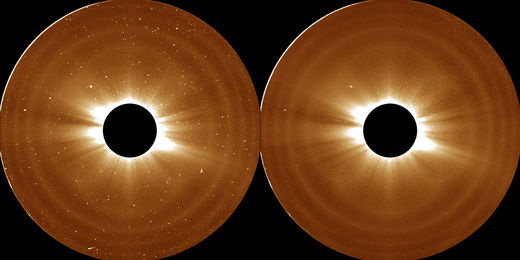NASA's Goddard Space Flight Center
Wed, 25 Jun 2014 22:45 CDT
Scientists used these observations of the sun's atmosphere (the bright light of the sun itself is blocked
by the black circle at the middle) from NASA's Solar Terrestrial Relations Observatory on Aug. 5, 2007,
to define the outer limits of the solar atmosphere, the corona.
These STEREO observations provide the first direct measurements of the inner boundary of the heliosphere -- the giant bubble sparsely filled with solar particles that surrounds the sun and all the planets. Combined with measurements from Voyager 1 of the outer boundary of the heliosphere, we have now defined the extent of this entire local bubble.
"We've tracked sound-like waves through the outer corona and used these to map the atmosphere," said Craig DeForest of the Southwest Research Institute in Boulder, Colorado. "We can't hear the sounds directly through the vacuum of space, but with careful analysis we can see them rippling through the corona."
The results were published in The Astrophysical Journal on May 12, 2014. The researchers studied waves known as magnetosonic waves, and they are a hybrid of sound waves and magnetic waves called Alfven waves. Unlike sound waves on Earth, which oscillate several hundred times per second, these waves oscillate about once every four hours -- and are about 10 times the length of Earth.
Read the rest of the article at : http://www.sott.net/article/280960-Much-larger-solar-corona-than-previously-observed

 RSS Feed
RSS Feed